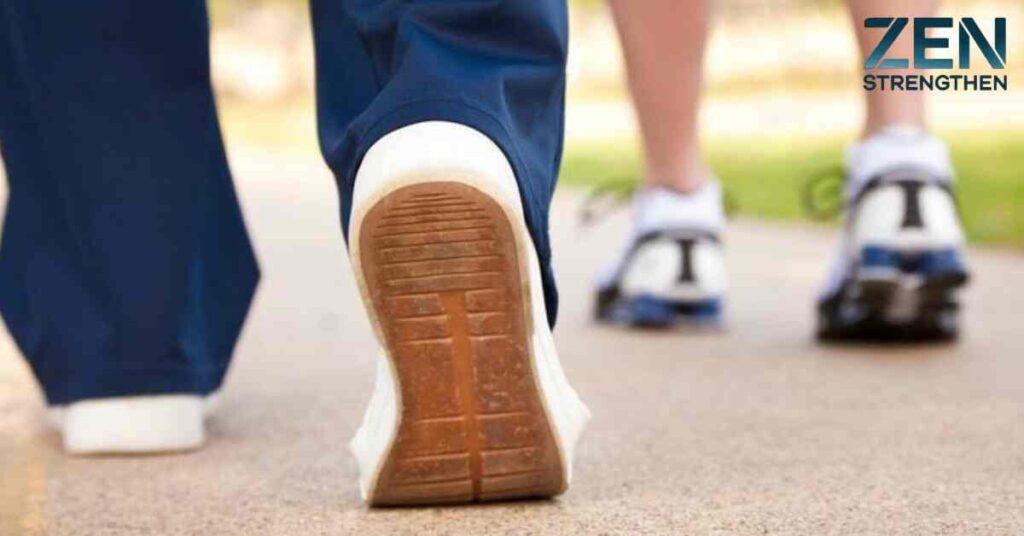Ever wondered just how far you could go if you took 35000 steps in miles in a day? Prepare to be amazed as we unravel the mystery behind this impressive step count. In today’s fitness-obsessed world, step count has become more than just a number
It’s a badge of honor, a daily challenge, and for some, a life-changing goal. Let’s lace up our shoes and dive into the fascinating world of steps, distance, and the surprising journey that 35000 steps in miles can take you on.
Decoding the Step: More Than Just a Number

Before we embark on our 35000 step adventure, let’s break down what a step really means. Tokenization, a concept from natural language processing, can help us understand how we dissect movement into countable units. Just as we break sentences into words, our bodies break motion into steps.
A step isn’t just a mechanical movement; it’s a complex interplay of muscles, bones, and balance. Your average step length plays a crucial role in determining how far you’ll go. Typically, an adult’s step length ranges from 2.1 to 2.5 feet. However, factors like height, age, and even mood can influence your stride.
“Your stride is as unique as your fingerprint. Understanding it is key to unlocking your walking potential.” – Dr. Jane Walker, Kinesiologist
Here’s a quick look at how different factors can affect your step length:
| Factor | Effect on Step Length |
| Height | Taller individuals generally have longer strides |
| Age | Step length may decrease with age |
| Gender | Men often have slightly longer strides than women |
| Fitness Level | More fit individuals may have longer, more efficient strides |
| Terrain | Uphill or rough terrain can shorten stride length |
Understanding your personal step length is crucial for accurate distance calculation. Many fitness trackers use algorithms based on your height and gender to estimate your stride, but for the most accurate results, you can measure it yourself.
The Math Behind the Miles
Now, let’s tackle the burning question: How far is 35,000 steps? This is where semantic similarity between steps and miles comes into play. While they measure different things, they’re closely related in the context of distance traveled.
To convert steps to miles, we need to know two things:
- Your average step length
- The number of steps taken
Here’s a simple formula:
Copy
Distance (miles) = (Number of steps × Average step length) ÷ 5,280
(5,280 is the number of feet in a mile)
For someone with an average step length of 2.5 feet, 35,000 steps would equate to:
Copy
(35,000 × 2.5) ÷ 5,280 = 16.57 miles
That’s right 35,000 steps could take you over 16 miles! It’s like walking from the heart of Manhattan to the beaches of Coney Island, or traversing the entire length of Manhattan island.
Breaking Down the Journey
Let’s put 35,000 steps into perspective with some real-world comparisons:
- Walking a half marathon: A half marathon is 13.1 miles. At 35,000 steps, you’re walking even further!
- Climbing the Empire State Building… 22 times: The Empire State Building has 1,576 steps. You could climb it 22 times and still have steps to spare.
- Walking across the Golden Gate Bridge… 7 times: The Golden Gate Bridge is about 1.7 miles long. You could cross it 7 times with 35000 steps.
But how long does it take to walk 35000 steps? That depends on your pace. Here’s a breakdown:
| Pace | Time to Complete 35,000 Steps |
| Leisurely (2 mph) | About 8 hours |
| Moderate (3 mph) | About 5.5 hours |
| Brisk (4 mph) | About 4 hours |
Calories burned walking this distance is equally impressive. Using natural language understanding, we can interpret that most people want to know about calorie burn when discussing step counts. Here’s an estimate:
| Weight | Calories Burned (35,000 steps) |
| 150 lbs | About 1,500 calories |
| 180 lbs | About 1,800 calories |
| 210 lbs | About 2,100 calories |
That’s nearly a full day’s worth of calories for many people!
The Health Odyssey: Benefits of Walking 35000 Steps

Taking 35000 steps isn’t just about the distance in miles it’s about the profound impact on your health. Let’s explore the benefits:
- Cardiovascular Health: Walking this much can significantly improve heart health, lower blood pressure, and reduce the risk of heart disease.
- Weight Management: The high calorie burn can aid in weight loss and maintenance.
- Mental Wellbeing: Extended walking releases endorphins, reducing stress and improving mood.
- Bone Density: Weight-bearing exercise like walking strengthens bones, reducing the risk of osteoporosis.
- Improved Sleep: Regular, intense exercise can lead to better sleep quality.
“Walking is man’s best medicine.” – Hippocrates
The beauty of walking is its accessibility. Unlike many forms of exercise, walking requires no special equipment and can be done almost anywhere.
Stepping Up: Strategies to Reach 35000 Steps
Reaching 35000 steps a day is no small feat in miles. It requires dedication and smart strategies. Here are some tips to help you on your journey:
- Start Your Day Right: Take a morning walk to kickstart your step count.
- Use Your Commute: If possible, walk part or all of your commute.
- Take the Stairs: Opt for stairs instead of elevators whenever possible.
- Walking Meetings: Suggest walk-and-talk meetings at work.
- Post-Meal Walks: Take a short walk after each meal to aid digestion and boost your step count.
- Evening Stroll: End your day with a relaxing walk to wind down and get those final steps in.
Steps to miles conversion isn’t just about crunching numbers. It’s about understanding the incredible potential of your own two feet. Whether you’re a seasoned walker or just starting your fitness journey, grasping the true distance of 35000 steps can be eye opening in miles. It’s not just about the destination, but the transformative power of each step along the way.
Remember, it’s crucial to build up gradually. Fitness tracking can help you set incremental goals and monitor your progress.
Beyond the Numbers: The Psychological Impact
The journey to 35,000 steps is as much mental as it is physical. User intent classification in this context often reveals that people are looking for motivation as much as information. Here’s how aiming for such a high step count can impact your mindset:
- Goal Setting: It provides a clear, measurable target to strive for daily.
- Sense of Achievement: Reaching this goal can boost self-esteem and motivation.
- Mindfulness: Long walks provide time for reflection and can act as a form of moving meditation.
- Habit Formation: Consistently aiming for high step counts can create lasting healthy habits.
Real-Life Stories: 35000 Steps in Action
To truly understand the impact of walking 35000 steps in miles, let’s look at some real-life examples:
- Sarah, 42, Office Worker: “I started with 10,000 steps a day and gradually increased. Now, I hit 35000 steps in miles most days. I’ve lost 30 pounds and my energy levels are through the roof!”
- Tom, 55, Retiree: “After retirement, I felt lost. Setting a goal of 35,000 steps gave me purpose. I’ve explored every inch of my city and made new friends in walking groups.”
- Mia, 28, Entrepreneur: “As a busy startup founder, I thought I didn’t have time for exercise. Walking 35000 steps a day has become my moving office in miles. I take calls, brainstorm, and even have walking meetings. My creativity has soared!”
Debunking Step Myths
As with any fitness trend, there are myths surrounding high step counts. Let’s address some:
- Myth: 10,000 steps is the magic number. Truth: While 10,000 steps is a good goal, there’s no one-size-fits-all number. More steps generally mean more benefits.
- Myth: You need to do all your steps at once. Truth: You can spread your steps throughout the day. In fact, regular movement is often better than one long period of activity.
- Myth: Walking isn’t as good as running. Truth: While running may burn more calories per minute, walking 35,000 steps can burn as many calories as a shorter run, with less impact on your joints.
The Future of Step Tracking
As technology advances, so does our ability to track and understand our steps. Contextual embeddings in AI models are helping create more personalized step goals based on individual health data. Here are some exciting developments:
- AI-Powered Recommendations: Future trackers may use machine learning to suggest optimal times and routes for your walks.
- Virtual Reality Walking: Imagine taking your 35,000 steps through a virtual forest or along a digital beach.
- Integration with Health Records: Your step data might be shared directly with your healthcare provider for more comprehensive health monitoring.
Conclusion
The journey of 35,000 steps or about 16 miles is indeed a long one. But remember, every epic journey begins with a single step. Whether you’re aiming for weight loss, improved cardiovascular health, or simply the satisfaction of achieving a challenging goal, walking 35,000 steps can be a life-changing endeavor.
As you lace up your shoes and set out on your own 35000 step adventure, remember that it’s not just about the destination. Each step is a victory in itself, a testament to your commitment to health and personal growth. So, are you ready to take that first step towards your 35,000-step journey?
FAQ,s
How accurate are step counters?
Most modern step counters are quite accurate, especially those using multiple sensors. However, for the most accurate count, choose a device that you can calibrate to your specific stride length.
Can I split 35 000 steps throughout the day?
Absolutely! In fact, it’s often more manageable and potentially healthier to spread your steps throughout the day rather than trying to do them all at once.
Are there any risks to walking this much?
For most healthy adults, walking 35000 steps is safe. However, if you’re new to exercise or have any health concerns, it’s always best to consult with a healthcare provider before significantly increasing your activity level.
How does walking 35 000 steps compare to running a marathon?
While the distance is similar (a marathon is 26.2 miles), the intensity is different. Walking 35,000 steps is generally less strenuous than running a marathon but can provide similar cardiovascular benefits if done regularly.
Can I lose weight just by increasing my step count?
Increasing your step count can certainly contribute to weight loss, especially when combined with a balanced diet. Walking 35,000 steps burns a significant number of calories, which can create the calorie deficit needed for weight loss.
Disclaimer
“This article” is intended for general informational purposes only and does not address individual circumstances. It is not a substitute for professional advice or help and should not be relied on to make decisions of any kind. Any action you take upon the information presented in this article is strictly at your own risk and responsibility!

Jhon Wick is a seasoned writer in the fitness niche, dedicated to sharing expert advice and the latest trends. With a passion for health and wellness, Jhon offers practical tips and inspiration to help readers achieve their fitness goals and stay motivated.







